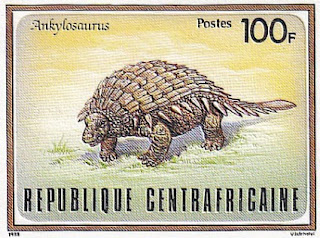Did Some Dinosaurs Re-Evolve?
The United States had a federal program called the Works Progress/Projects Administration for employing people from 1939-1943. (I knew a guy who had been on it, and he referred to the WPA as "We Putter Around".) They did mainly construction work such as roads, but some excavated fossils. In 1940, an odd dinosaur fossil fragment was found by WPA folks, and it was reexamined recently.
 |
| Modified image of an ankylosaurus postage stamp from Central Africa in my collection. It was called ankylosaurus because it would bite you on the ankles, making them sore. |
An American research team recently reanalyzed a strange fossil the Works Progress Administration excavated in 1940 from the Triassic Otis Chalk in west Texas. This partial skull showed that the animal had a huge, thick dome on its head, much like pachycephalosaurs found in Cretaceous deposits. According to conventional consensus, 100 million years and a vicious extinction event separate the two fossil types. What role did an evolutionary perspective play in this team's conclusions about this supposedly out-of-place dome-headed fossil?.To read the rest, click on "Out-of-Place Dome-Headed Reptile".
The skull goes by the genus name Triopticus and bears a strange pit in its middle. Its new description appears in the journal Current Biology, along with an interpretation of what must have happened to produce two very similar reptiles so distantly separated in evolutionary time.